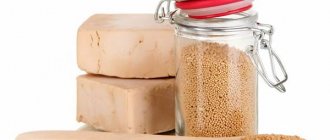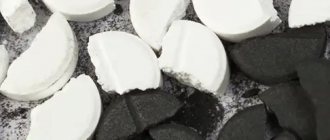Reading about the beneficial properties of indoor plants, I saw that poisonous Dieffenbachia has not only negative qualities. Surprisingly, this large plant is capable of purifying the air from substances harmful to the human body.
However, the flower is poisonous, and improper handling can lead to adverse consequences. I'll tell you why you can't keep Dieffenbachia at home.
Botanical description
Dieffenbachia belongs to the genus of evergreen plants of the Araceae family. It has a developed root system and a thick juicy stem. When grown at home, its height reaches from 0.5 to 2 m.
Dieffenbachia leaves have an oblong shape and are alternately arranged on the stem. They are painted yellow-green, which is beautifully set off by a marble pattern of spots or stripes. Drops of liquid periodically appear at the tips of Dieffenbachia leaves; these “tears” indicate increased air humidity and can predict imminent rain.
Dieffenbachia blooms in the spring, usually in April or May. But when kept at home, this rarely happens. The decorative value of Dieffenbachia is associated with the variegated pattern of the leaves. The small flowers, collected in a spadix, have an attractive yellowish-white hue.
Dieffenbachia is a poisonous plant. Its species that can cause intoxication, and are often grown at home, are as follows.
- Variegated Dieffenbachia - has a characteristic marble pattern of light spots and stripes.
- Oersted - leaves painted a solid green color with a white streak in the middle.
- Spotted Dieffenbachia - its name comes from its large light spots.
- Leopolda - dark green leaves with light veins.
- Lovely Dieffenbachia - decorated with large leaves up to 50 cm and a tall stem up to 1.5 m.
- White flame - the leaf pattern resembles tongues of fire.
The systematization of Dieffenbachia varieties is very confusing. However, the beginning of existing ornamental plants was laid by the selection of two varieties - spotted and variegated.
In nature, Dieffenbachia grows in the tropical forests of South and Central America.
For pets
Having learned whether Dieffenbachia is poisonous to people, let’s look at the situation with pets. Cats are very persistent in their desires, and if she decides to try this plant, rest assured, these cunning animals will get their way. When you're at home, you can ward off annoying foodies, but what happens when they're left alone? To avoid disaster, it is better to keep animals and Dieffenbachia in different rooms. Where the dangerous beauty will live, there is no place for curious four-legged creatures.
However, you should not fall into despair now, having discovered that that gorgeous flower that has been living with you for quite a decent time is nothing more than a poisonous Dieffenbachia. And at the same time, your beloved cat lives with you in the same rather modest living space. If he hasn’t touched the flower yet, then most likely he won’t do it.
Dogs can also taste Dieffenbachia, so it's worth taking safety precautions. The same goes for parrots. They can pinch off a piece of juicy greenery... For parrots, such a meal with a high degree of probability may be their last.
Beneficial features
The history of Dieffenbachia cultivation is almost two hundred years old. Such a long acquaintance allowed us to study the plant in many ways, including as an object for decorative use at home.
Useful properties of Dieffenbachia:
- regulates indoor air humidity, promotes dust settling on the surface;
- releases phytoncides - biological active substances that suppress the growth and development of pathogenic bacteria;
- absorbs harmful components of exhaust gases;
- neutralizes toxic substances contained in finishing materials of residential premises, cleaning products and detergents.
However, the positive qualities of Dieffenbachia do not negate the danger of this plant, since its juice contains poison. It contains oxalic acid, its derivative calcium oxalate, alkaloids, and essential oils. The flower can cause significant harm to the health of people and pets.
Possible diseases
With increased soil moisture, the base of the stem softens and a fungus appears on the plant. You need to remove the bush from the pot, remove the rotten roots and replant it in fresh soil with added activated carbon. At low air temperatures, the leaves of the flower become covered with brown spots and curl up. When exposed to direct sunlight, the color of the plant fades. The flower should be moved to another room.
If you are not a superstitious person and take precautions when handling Dieffenbachia, then feel free to grow this ornamental shrub at home. Dieffenbachia will add a touch of exoticism to any interior and will delight with its colorful appearance.
Dieffenbachia
Why is Dieffenbachia flower dangerous for humans?
Oxalic acid harms biological tissues of the body. It has a destructive effect upon contact with the skin, mucous membrane of the mouth, pharynx and larynx. It is based on irritation followed by inflammation and the appearance of a chemical burn reaction. There is evidence that the volatile components of Dieffenbachia juice can provoke irritation of the nasal mucosa, upper respiratory tract, eyes, and headaches.
Dieffenbachia can cause allergies. The risk group includes people with reactions to dust, pets, and citrus fruits.
When processing a plant without using gloves, the poisonous juice from the hands gets into the mucous membrane of the eyes.
Dieffenbachia leaves and flowers can be unintentionally eaten by a child. Pets are at the same risk.
Esotericists believe that Dieffenbachia is included in the list of plants that can change the energetic atmosphere of a home. Energy practitioners attribute the following properties to it:
- disrupts the harmony in the relationship of married couples;
- negatively affects potency in men, leading to infertility;
- prevents girls from matrimonial plans;
- extinguishes the negative energy of quarrels and family discord.
Such information may seem contradictory and exaggerated. However, it is worth remembering that the flower is popularly called muzhegon; it is perceived as a symbol of celibacy. Therefore, it cannot be ruled out that Dieffenbachia, which is poisonous to humans, releases substances that negatively affect reproductive function during prolonged contact.
Why is Dieffenbachia dangerous?
Folk signs
The benefits of a beautiful flower have been known for a long time. There is a popular belief that Dieffenbachia has magical powers and it depends only on a person’s behavior whether it will emit harm or benefit.
Benefits of Dieffenbachia
- The plant can bring good luck and wealth to the house.
- Dieffenbachia fills the house with positive energy. She is able to give kindness to household members and provoke the appearance of confidence and determination in their character.
- If the relationship between spouses has deteriorated, quarrels and disagreements often begin to arise, folk sages advise placing a flower in the kitchen. The positive energy of the plant will help lovers find the right solution to their disputes.
- The flower has a positive effect on feminine energy. If ladies want to remain young, charming and sexy for a long time, then the plant should be placed in a large room and constantly monitor the cleanliness of the leaves.
- Dieffenbachia, growing in offices and offices, increases the productivity of employees in the relevant production.
Harm of Dieffenbachia
- Among the people, Dieffenbachia is given the name “muzhegon”. If a single girl gets a plant, it will be difficult for her to find a faithful life partner.
- It is strictly forbidden to place a flower pot in the bedroom; this negatively affects the sex life of the spouses.
- Dieffenbachia is considered a purely female flower. If a man grows it at home, it will negatively affect his personal life. Moreover, the plant can even cause infertility in men.
- The flower also has a negative effect on the well-being of men. The older the plant, the more often it provokes the appearance of malaise, apathy, irritability, mental disorders and nervousness in representatives of the stronger half of humanity.
Causes of Dieffenbachia poisoning
Intoxication can occur:
- through the skin;
- mucous membranes;
- by inhalation;
- by the food route when it enters the gastrointestinal tract.
Most cases of Dieffenbachia poisoning occur through contact with skin or mucous membranes. You can usually avoid the plant's toxic effects by being careful, but children and pets are always the weak link. They may use an unconventional method to become acquainted with an attractive flower - chew parts of the plant, pick off the leaves, and then rub their eyes.
When bringing Dieffenbachia into the house, adults should be aware that their child can be poisoned by a poisonous plant, suffering a burn to the skin, eyes, mucous membranes, or digestive upset.
Reviews
Yana: We have one with variegated leaves in a pot at home. I never even thought that it could be poisonous. There were no incidents.
Nikita: We have had Dieffenbachia for many years, it looks like a real tree. Children cannot reach the leaves - we always monitor this.
Sveta: When I found out that the plant was dangerous, I immediately gave it away, since there are several cats at home. I'm scared for the animals - they might chew them up and suffocate, why is such a risk necessary?
Skin burn
The poisonous juice of Dieffenbachia comes into contact with unprotected tissues during processing of the plant, cutting off leaves, stems, and peduncles. Therefore, in order to avoid poisoning, any interaction with the flower must be carried out with gloves.
Symptoms will resemble a skin burn:
- acute pain;
- burning, itching;
- redness, swelling of the site of contact with the poison.
How to treat a skin burn from exposure to Dieffenbachia? It is enough to quickly wash off the juice with running water, including rinsing your mouth and nose. Do not rub the skin in an attempt to completely remove the aggressive substance. For severe pain, you can take a drug with an analgesic effect.
Conditions of detention
Possible intoxication of the body can be eliminated if all the necessary conditions for keeping the flower are fully observed. The plant is extremely unpretentious; for its normal growth it is recommended to provide light light, a humid environment and a warm atmosphere.
Dieffenbachia does not need frequent watering; you need to pay close attention to this only while the plant is young. In winter, the flower is watered only after the soil has dried to a certain depth.
Obviously, the benefits of such a plant are much greater than its negative effects. This is what causes the plant to spread so widely. Nevertheless, it must be cared for with the utmost care, and access for small children and animals, especially cats, should be completely limited - for them, the plant sap is a real poison.
Burn of mucous membrane
A special case when toxic substances settle on the mucous membrane of the nose, oral cavity, and larynx. Signs of Dieffenbachia poisoning indicate acute respiratory failure:
- burning sensation, pain, soreness;
- increased respiratory movements;
- dry whistling cough;
- dyspnea.
If swelling of the mucous membrane causes obstruction of the respiratory tract, there is a threat to human life. Symptoms of insufficient oxygen supply to the body may appear:
- bluish skin;
- depression of consciousness;
- decreased blood pressure;
- development of a terminal condition.
It is necessary to immediately call an ambulance and do not leave the victim alone until medical specialists arrive. Monitor his consciousness, breathing, blood pressure, heart rate. If a terminal condition develops, begin cardiopulmonary resuscitation.
If Dieffenbachia juice gets into the eyes, a burn appears, the depth of which may vary. The severity depends on the concentration and time of exposure to the damaging factor. The victim may complain of pain, burning, swelling, inability to open the affected eye, lacrimation, and blurred vision.
What to do if your eyes are burned by Dieffenbachia juice?
- Rinse the cavity with a stream of water so that the liquid does not get on the healthy side, applying a protective bandage to the unaffected eye (especially important for children).
- Seek medical attention immediately.
A hardware and clinical examination will be carried out at the emergency room. Only a medical specialist can adequately assess the depth of the lesion. The doctor will prescribe a comprehensive treatment - analgesics, if there are indications - antibacterial, healing drugs, physiotherapeutic procedures. If necessary, the victim is hospitalized in a hospital.
Allergy to Dieffenbachia
What to do if Dieffenbachia juice gets on your skin and causes an allergic reaction? Symptoms can be divided into local and general.
If a localized rash, itching, or blisters appears, take antihistamines and monitor the body's reaction. If further development of symptoms does not occur, then the following conclusions should be drawn:
- the impact was local;
- next time the reaction will be more violent and unpredictable.
General symptoms occur with the development of acute respiratory and cardiovascular failure. The severity of the condition requires immediate hospitalization and intensive care in the intensive care unit.
Food poisoning
If you eat parts of the Dieffenbachia plant, it will initially show signs of burning. These include:
- pain, burning, itching, tingling;
- in the case of children - motor and emotional agitation, inability to come to an agreement or fulfill requests;
- swelling and redness of the lips, oral mucosa;
- increased salivation;
- difficulty breathing, swallowing, producing sounds (speech).
Later the symptoms of food poisoning appear:
- nausea;
- vomit;
- pain;
- pain in the stomach area;
- diarrhea (frequent loose stools).
What to do in case of Dieffenbachia food poisoning, for example, if a child has eaten a poisonous plant? Immediate medical attention will help neutralize the toxic substance. Independent lavage of the stomach and even the oral cavity can cause complications in the form of aspiration (flow of gastric contents into the respiratory tract) and spread of the burn area. This occurs against the background of difficulty swallowing, breathing, and the inability to communicate calmly. Severe sudden pain causes fear and inappropriate behavior of the child. Before the ambulance arrives, adults should distract him and provide psychological support.
Specialized treatment for Dieffenbachia food poisoning includes:
- adequate pain relief;
- hardware diagnostics (FGDS);
- gastric lavage;
- infusion (intravenous drip) of saline solutions;
- respiratory therapy - humidified oxygen, artificial ventilation;
- correction of gastrointestinal tract functions;
- prevention of complications.
The prognosis for the development of complications after Dieffenbachia food poisoning depends on how soon intensive therapy is started. The decisive factor in the fight against poison is time. Rapid removal of toxins from the gastrointestinal tract significantly reduces their absorption.
Let's sum it up
As it becomes clear from our article, Dieffenbachia is poisonous, but will only cause harm if it is treated negligently. If you do not chew the plant and work with it, protecting your hands with gloves, horrors will not happen. But the benefits of the flower are significantly reduced. Excellent cleaning properties should not be ignored. It is quite acceptable to keep it in office and industrial premises, in residential apartments and houses. It is enough just to stop communication between your child and the plant and to delimit the presence of animals together with him.











